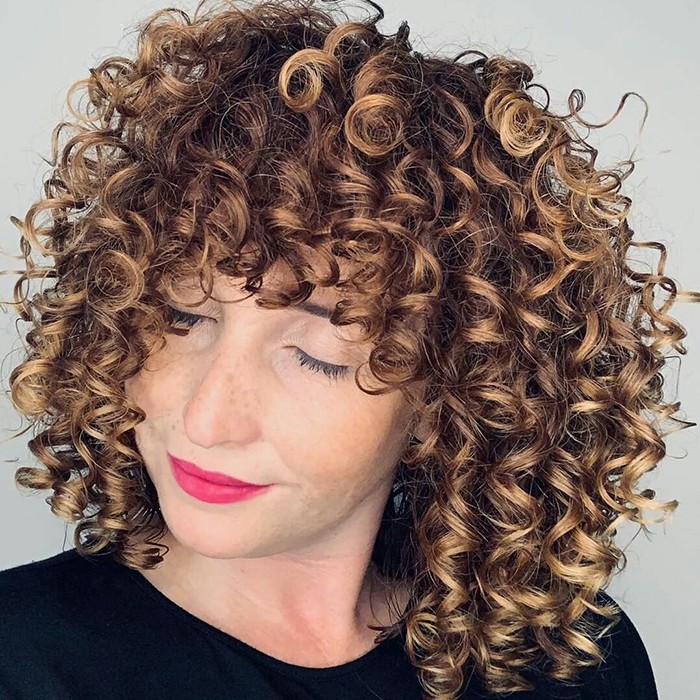
IMAGE SOURCE: @ACTUALLYALICIA.CURLS, USING ECOSLAY (LISTED BELOW”>
Silicones are like little magicians, creating the illusion of silky, shiny hair; however, frustratingly, they can actually cause a reduction of gloss and shine over time. Silicone is not a natural ingredient; it’s a synthetic polymer that coats the hair, giving the initial appearance of shine, but causing build-up over time as they are difficult to remove. In addition, heat from styling tools or dryers can cause the silicones to bind to your hair. This means that other products such as deep conditioners, can’t work their magic on your hair as they can’t penetrate this synthetic barrier. This layer also prevents moisture from being absorbed as well, thus causing the hair to become more brittle and drier over time.
What are the benefits of going silicone-free?
It stands to reason therefore, that creating a regime without silicones should leave you with healthier, more moisturized hair. Your hair will be able to absorb vitamins, protein as well as moisture without the polymer barrier created by ‘cones. Another benefit is that you will no longer need to use harsh shampoos to remove silicone build-up. Think of it as reaping the benefits of a long-distance run over a short-distance sprint. You may get instant gratification from using ‘cones, but the effect of that will be over pretty quickly. Caring for your hair over the long-term without ‘cones will allow your hair to flourish.
Which silicones should be avoided?
Put simply, avoid using any non-water-soluble silicones i.e. any that are not easily removed. Check your ingredients list and look out for any that end with ‘cone’, ‘con’ ‘zane’ or ‘xane’. likelovedo.com recommends this list of ‘cones to avoid:
- Amodimethicone
- Aminopropyl triethoxysilane
- Behenoxy Dimethicone
- Bis-aminopropyl dimethicone
- Bis-isobutyl Peg/Ppg-20/35/Amodimethicone Copolymer
- Botanisil
- Cetearyl Methicone
- Cetyl Dimethicone
- Cyclomethicone
- Cyclopentasiloxane
- Dimethicone
- Dimethiconol
- Dimethicon
- Disiloxane
- Di-Isostearoyl Trimethylolpropane Siloxy Silicate
- Hexamethyldisiloxane
- Microsil
- Silane
- Silicon
- Siloxane
- Siloxysilicate
- Silsesquioxane
- Silylate
- Stearyl Dimethicone
- Phenyl trimethicone
- Polysilicone-18 Cetyl Phosphate
- Trimethylsiloxysilicate
- Trimethylsilylamodimethicone
Water-soluble silicones usually begin with ‘peg’ and these can be washed out with co-wash alone. Because silicones create a barrier around the hair, these easily removable silicones can protect against damage like heat styling and sun damage.
You can learn more about water-soluble silicones and a list of ingredient names to look for here: Water Soluble Silicones 101.
How to give up silicones
It might seem scary to give up on products that you’ve turned to in the past for instant shine. Common challenges might be that your hair may well feel drier initially as it adjusts, and you may notice more flyaways and frizz; however, in the long term, as your hair loses its reliance on silicones and becomes healthier, absorbing regular moisture and other vitamins from your products, it will thank you for the change. Here are a few steps to help you to give up silicones:
Step 1: Remove Silicone Build-up
Initially, you will need to strip the silicone build-up from your hair using a clarifying shampoo. If you use one with sulfates, you will need to deep condition afterwards to replenish moisture.
Try an apple cider vinegar rinse to help remove the build-up; it also has the added bonus of imparting a beautiful shine on the hair because it softens and smooths the hair cuticle.
Step 2: Identify the Silicones in Your Current Regimen
Ensure all your products are silicone-free using the list above to check against the ingredients list. They are usually present in shampoo, conditioner and deep conditioner, but it’s worth checking all of your products just in case those sneaky ‘cones are present!
Step 3: Replace Them with Silicone-Free Alternatives
Once you’ve removed the silicones from your product lineup, you will need to replace those products in your routine. We’ll include a list of cone-free brand recommendations below as a starting point. Look for alternative ways to encourage the natural shine of your hair, for example. incorporate hair oils into your routine. Broccoli seed oil has been praised as a natural alternative to silicones; it contains an Omega-9 fatty acid that can create shine on your hair. Silicone-free hair serums are also a good way to incorporate shine and they can provide some protection against heat and chemical damage.
Cone-free Product Recommendations
The following are a few of the brands that offer silicone-free products or ranges of products:
- Tresemme Pro Collection Botanique Range
- Boucleme
- Flora & Curl
- Only Curls
- Ecoslay
- Garnier Ultimate Blends Hair Food Range
- Infinitii Oils offer silicone-free Shampoo and Conditioner as well as hair oil
- Umberto Giannini Banana Butter Range
- Alaffia Beautiful Curls
Going silicone-free can be an instrumental step in discovering your curls in their natural state, but it is not the only way to be curly. Some curlies find that going mostly-silicone-free and using silicones in specific scenarios, like for heat protection, works best for them. It’s all about finding the regimen that meets your personal needs!
Read next: Top 20 Silicone-Free Daily Conditioners
This article was originally published in 2014 and was updated in 2021.
